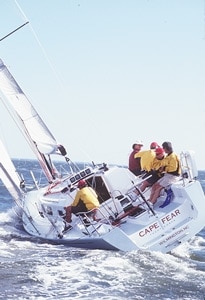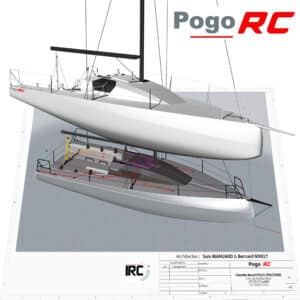
Production boat builders limit options on new boats to keep costs down and target the purpose of the boat. When the options expand to the level of those available on the Cape Fear 38 by Cape Fear Yacht Works, builders reach semi-custom territory and the price naturally escalates as well. For a new organization like Cape Fear, which has produced its first boat and initially plans just a couple of new boats a year, being open to a prospective owners desires can help attract clients whod like to have a hand in their new boat.
For boating writers like myself, defining the racer/cruiser, cruiser/racer divide, can be confusing: What is it, whos the target buyer, how do I describe a moving target to readers? Well, I guess I just did, the Cape Fear 38 is a moving target, albeit a fast one, waiting for an owners final touches. Want a wheel instead of a tiller, inboard or outboard chain plates, deep draft or shallow and a cruising or stripped out racing interior, great! Even the companys vision: “Designed to Race, Outfitted to Cruise, Built to Last” promises choices.
I sailed the prototype twice, once in October of 2001 during Boat of the Year testing on the Chesapeake and again this spring on the Cape Fear River near the companys boatbuilding operation in Wilmington, NC. The second sail was arranged because the rudder was slightly mis-aligned in the rush to get the boat to the US Sailboat show in Annapolis and steering wasnt optimal–as a matter of fact it was awful. Id originally been excited to see the boats open stern, tiller steering, and racing cockpit and had high expectations but when sea trials came around I masked my disappointment by suggesting another sail when the problem had been addressed.
With the alignment problem fixed, Hill Goodman, the company’s Director of Sales and Marketing, called and invited me to try again. I was to sail with Bruce Marek, the boat’s designer, Goodman and Sailing World mid-atlantic sales manager Ted Ruegg. Jammed for time we elected not to take the three-hour trip down the Cape Fear River from Wilmington to the ocean, but instead tacked up the river’s narrow ship channel.
Under overcast skies with a 12-knot breeze blowing straight downriver we raised the main and 100 percent jib on the aluminum Charleston spar and with Marek trimming main we tacked upstream. One side of the river has commercial docks for ocean going ships and the other is an undeveloped tidal estuary dominated by saw grass and wading birds. Along this far shore local fisherman had set a line of crab pots right on the edge of the ship channels deep water, so it was easy to know where and when to tack back towards the civilized shore.
As a kid, I grew up sailing on the Achushnet River and while the vegetation didnt match my Massachusetts home waters, the wind variations caused by sailing into the shadow of large ships and piers felt quite natural as we tacked almost 50 times to travel the two or three miles upstream to the citys center. The exercise gave me a good feel for the boats handling characteristics. It tracked to weather exceedingly well, turned almost in its own length and at 11,000 pounds carried momentum through the tack well enough that a sudden blanketing of breeze didnt faze us.
At one point a tug and barge heading downstream forced us to wait between two piers. I headed the boat into the wind and current, feathering and maintaining position for several minutes like I was Russell Coutts on the start line of the last Americas Cup match. Well, no one will confuse me with Coutts or the Cape Fear 38 with an AC boat but I was pleased enough with the performance to at least keep my fantasies in play.
We reached the downtown bridge and turned with the streams flow. Heading downwind we unfurled the a-sail tacked to the pulpit, rolled up the jib and with the narrow channel restricting jibe angles, went wing-and-wing at almost 10-knots through the water. Not bad, considering we werent on our optimal jibe angles, but I couldnt help feeling the boat was more oriented to cruising despite the speed.
Two regattas showed the challenges ahead for this boat. At Charleston Race Week the boat was last, albeit with a rookie crew, in an 11-boat fleet and in the Wrightsville Beach to Beaufort race the boat was last in each of three light-air races–finishing fifth, and in the one race with 10 to 12 knots of air, they took a third.
The rating was changed from a 57 in Charleston to a 63 in NC, but far from the designers expectation of a fair rating–69 to 72. Goodman feels that hull No. 1 is a prototype and a transition boat which has brought them to a fork in the road. And that they have tried to make hull No. 1 something thats inherently a compromise–a shallow draft racer/cruiser. According to Goodman, Cape Fear Yacht Works will be showing two distinctly different boats in Annapolis this year. One will be the fast cruiser, much like the one I sailed, with a less aggressive rig, a wheel, and roller-furling themes, possibly lazy jacks for the main, easily handled by one or two people. This family friendly version will be for those who arent real serious about racing. The cockpit will be more traditional, with seats and an enclosed transom. This version will hit the water mid-summer.
The other boat will be the CF-38 “regatta” version which will be a somewhat stripped out 10,000 pound displacement and will be set up to race. It will draw seven feet with a retractable pole for asymmetric chutes. It will have the open cockpit I test sailed, a big wheel and modified deck layout, higher sheer, and lower cabin top profile. The good news is that sometimes allowing a target to move helps focus a boat and Ill be looking forward to the next two versions of the Cape Fear 38.
Cape Fear 38 Specs
LOA 38 ft.
Beam 11 ft.
Draft 6.0 ft.
Dspl. 11,000 lbs.
SA 800 sq. ft.
www.capefearyachtworks.com
910-790-1990









